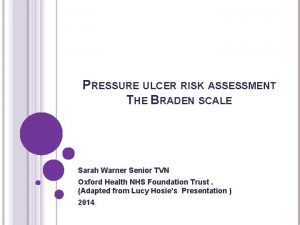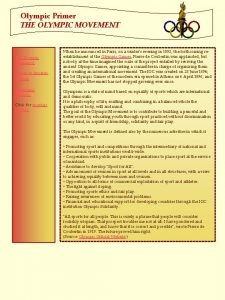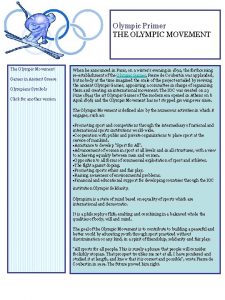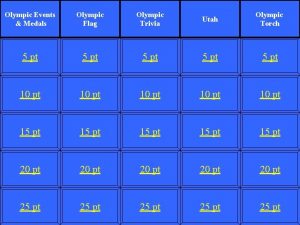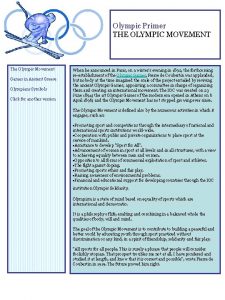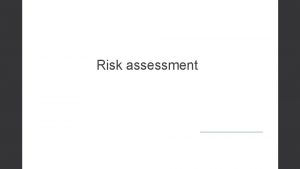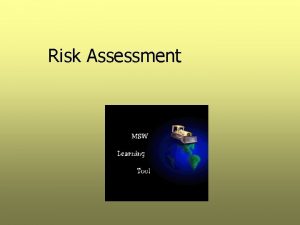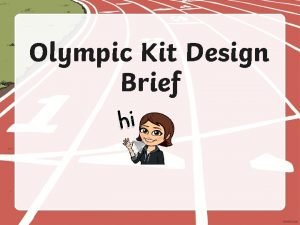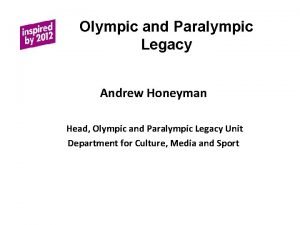Outdoor Risk Assessment Sarah SalazarTipton Sarah Greenwald Olympic





![Benefit-Risk Assessment: A process of identifying hazards and [challenging] play elements in early childhood Benefit-Risk Assessment: A process of identifying hazards and [challenging] play elements in early childhood](https://slidetodoc.com/presentation_image_h/1201d17619e09100d79009b7636169e6/image-6.jpg)

























- Slides: 31

Outdoor Risk Assessment Sarah Salazar-Tipton Sarah Greenwald Olympic Nature Experience

Who are we?


Who are you? Name School What kind of time do you spend outdoors?

Skills, questions, concerns or barriers around nature time?
![BenefitRisk Assessment A process of identifying hazards and challenging play elements in early childhood Benefit-Risk Assessment: A process of identifying hazards and [challenging] play elements in early childhood](https://slidetodoc.com/presentation_image_h/1201d17619e09100d79009b7636169e6/image-6.jpg)
Benefit-Risk Assessment: A process of identifying hazards and [challenging] play elements in early childhood outdoor play and making plans to mitigate childrens risk of injury while maintaining the developmental benefits for children. This process includes: 1. Identifying the types of risk present in a location or activity 2. The likelihood or severity of potential injury 3. The potential benefits to children 4. And making a plan that: Mitigates hazards (elimination, substitution, isolation, safeguards) Manages risk (heightened supervision, scaffolding, intervention) Outlines who is responsible for implementing and when -From the Washington Department of Children, Youth and Families Outdoor Preschool Pilot- Draft definitions

Ideas Regarding Risk: Exposure to something unpleasant, challenging or dangerous Danger: The possibility of suffering harm or injury Challenge: A task or situation that tests one’s abilities

Ideas Around Safety: A set of conditions setup to prevent harm, injury or danger (static) Protection: Taking steps to prevent injury or danger (active)

Safety vs. Protection Safety = Bubble Protection = Skill Set

Benefits of Risk-Taking ● ● ● ● Practice Critical Thinking and Self-Reflection Develop Motor Skills Increasing Awareness Developing Social Skills Cultivating Confidence and Courage Build Up Grit & Resilience Emotional Regulation Awareness of Personal Abilities

Margin of Error Theory

Margin A border around something

Margin Before Error Dependent on a child’s ability. Ask yourself: How likely is it that something will go “wrong”?

Margin Before Consequence Dependent on the environmental factors. How harmful are the options when something does go wrong?

Danger Outside of these margins potentially lies danger.

Two Major Jobs As Teachers 1. Protecting the children by keeping the margin before consequence large, like a safety net.

Two Major Jobs As Teachers 2. Teaching the children how to protect themselves. Teaching them how to increase their margin before error, like a bigger platform to stand on.

How do WE keep the children’s environment safe and protected? ● We create nurturing, trusted relationships ● We meet their needs ● We teach them awareness - which create extra eyes and ears ● We look out for hazards (safety checks of a space, hike with shoes on) ● We create boundaries (safety cones, don’t climb higher than a teacher’s shoulder) ● We create safety routines (example: trail calls, magnet finger, holding hands when crossing the street)

How do we teach the children to keep THEMSELVES safe and protected? ● We teach them awareness tools ● We teach them emotional and self-regulation tools (I am angry, what do I do now? Should I put on a sweater? ) ● We allow them the space to self assess their own safety ● We give them the room for challenging play so they know the consequences, their abilities and their body cues (what does it feel like to jump off a log? What about off a table? ) ● We use reflective language instead of praise (Do you feel scared? Are you excited when you climb that high? ) ● We use empowering language and actions, when needed, to build their own trust in themselve (I believe in you, do you want to try? )

Be Careful versus Pay Attention Safety Protection

Our in-class Model

Seasonal Risk Assessment

Environmental vs. Developmental Risk Environmental Risk: Risk associated with an environment and the activity that will take place there Developmental Risk: Risks associated with the children’s needs, their emotional safety and how much help they will need to navigate a challenge and prevent danger

Levels of Environmental Risk 1. Low Risk: Acceptable natural consequences for a child. May cause slight upset or behavioral change and no injury. 2. Medium Risk: May cause slight injury involving band-aids, crying, bruising, or physical discomfort. 3. High Risk: Involves a call home, break from play, altering of class behavior, and/or incident report. 4. Dangerous Risk: Unacceptable level of risk that could lead to policy change, program change. Loss of trust from families, unsafe class or working environment.

Levels of Developmental Risk 0. Able to navigate on own: A child or class is likely to navigate this challenge on their own successfully. 1. 50% Support Needed: A child or class will need some help in navigating this challenge on their own. 2. Unable to navigate without support or unpredictable: Child or class will definitely need support and may be unlikely to accomplish challenge even with support.

Environmental vs. Developmental Risk Environmental: Weather, Activity, Environment Developmental: Ability to navigate challenges

Teacher Readiness One last piece to consider is teacher training and readiness. If you have a staff member who is new, not fully trained, or unwell, you may consider adding 1 to the Entire Risk Assessment. If you have an emergency, can you rely on this person’s training and tools? What about their awareness? Are they able to create the developmental support necessary to minimize danger?

Examples from our class

Now it’s your turn. . .

Questions, concerns, scenarios. . .

Thank You. We hope you enjoy some challenging play today.
 Litizzazione significato
Litizzazione significato Michael b greenwald
Michael b greenwald Sarah risk assessment
Sarah risk assessment Braden scale score
Braden scale score Market risk credit risk operational risk
Market risk credit risk operational risk What is risk projection in software engineering
What is risk projection in software engineering Avoidance risk
Avoidance risk Relative risk calculation
Relative risk calculation Residual risk and secondary risk pmp
Residual risk and secondary risk pmp Tracing vs vouching
Tracing vs vouching Absolute risk vs relative risk
Absolute risk vs relative risk Activity sheet 2 stock market calculations
Activity sheet 2 stock market calculations Risk classification
Risk classification Risk financing retention adalah
Risk financing retention adalah The biggest risk is not taking any risk
The biggest risk is not taking any risk Fiduciary investment risk management association
Fiduciary investment risk management association Business risk audit
Business risk audit Business risk vs financial risk capital structure
Business risk vs financial risk capital structure Attributable risk formula
Attributable risk formula Risk map risk management
Risk map risk management Parirt
Parirt Olympics powerpoint presentation
Olympics powerpoint presentation The olympic games are an international sports festival
The olympic games are an international sports festival Where is the first olympic held
Where is the first olympic held Purpose of olympic
Purpose of olympic The ancient olympic games were initially
The ancient olympic games were initially Olympic symbols
Olympic symbols Hotel olympic prague
Hotel olympic prague Renaissance hotels 职位
Renaissance hotels 职位 Citius altius fortius communis
Citius altius fortius communis Ancient olympic ceremonies
Ancient olympic ceremonies 776 bc means
776 bc means



